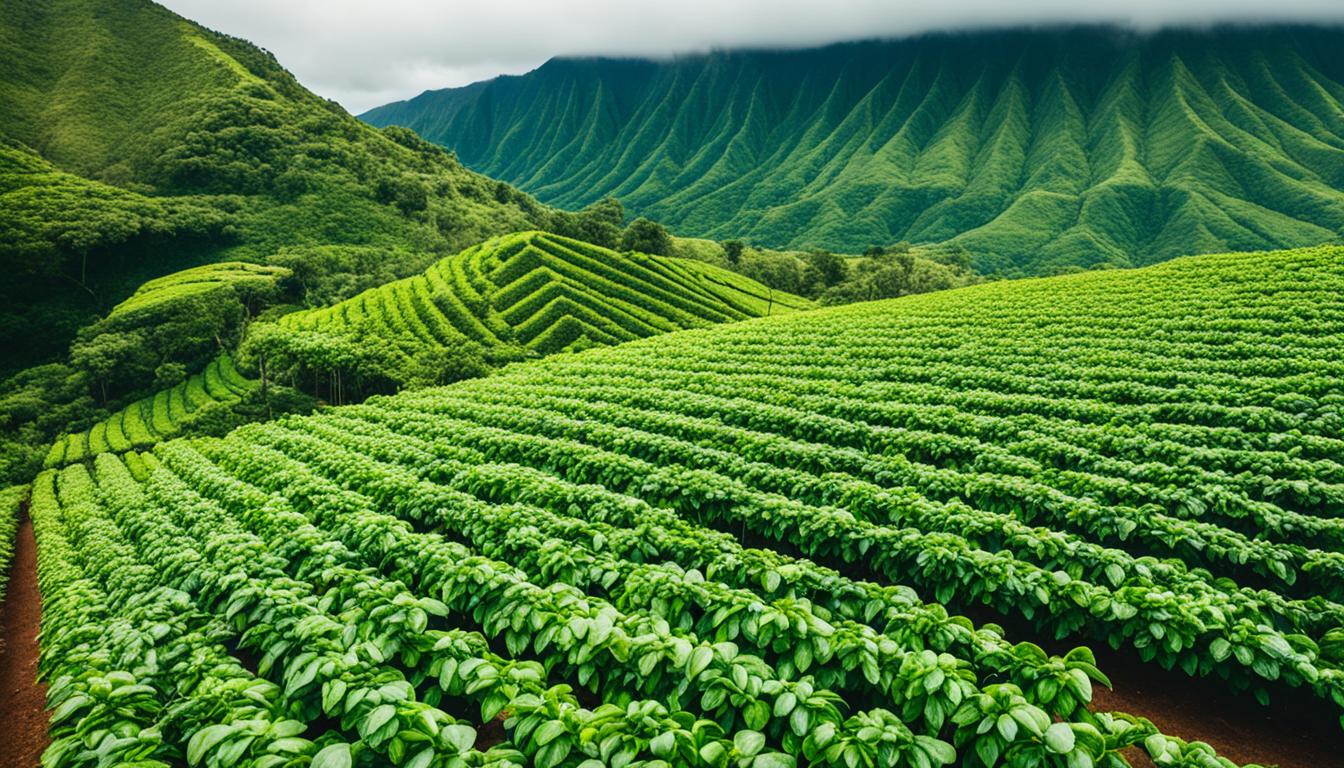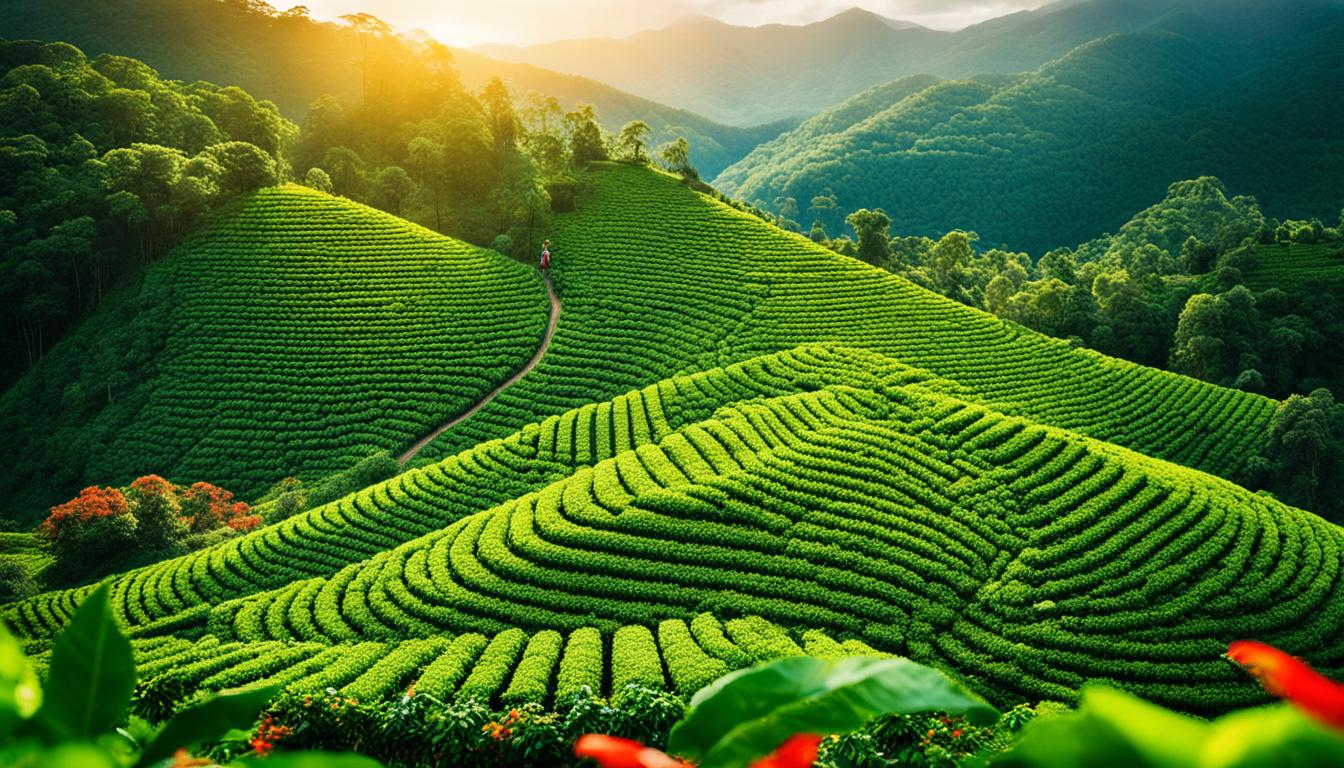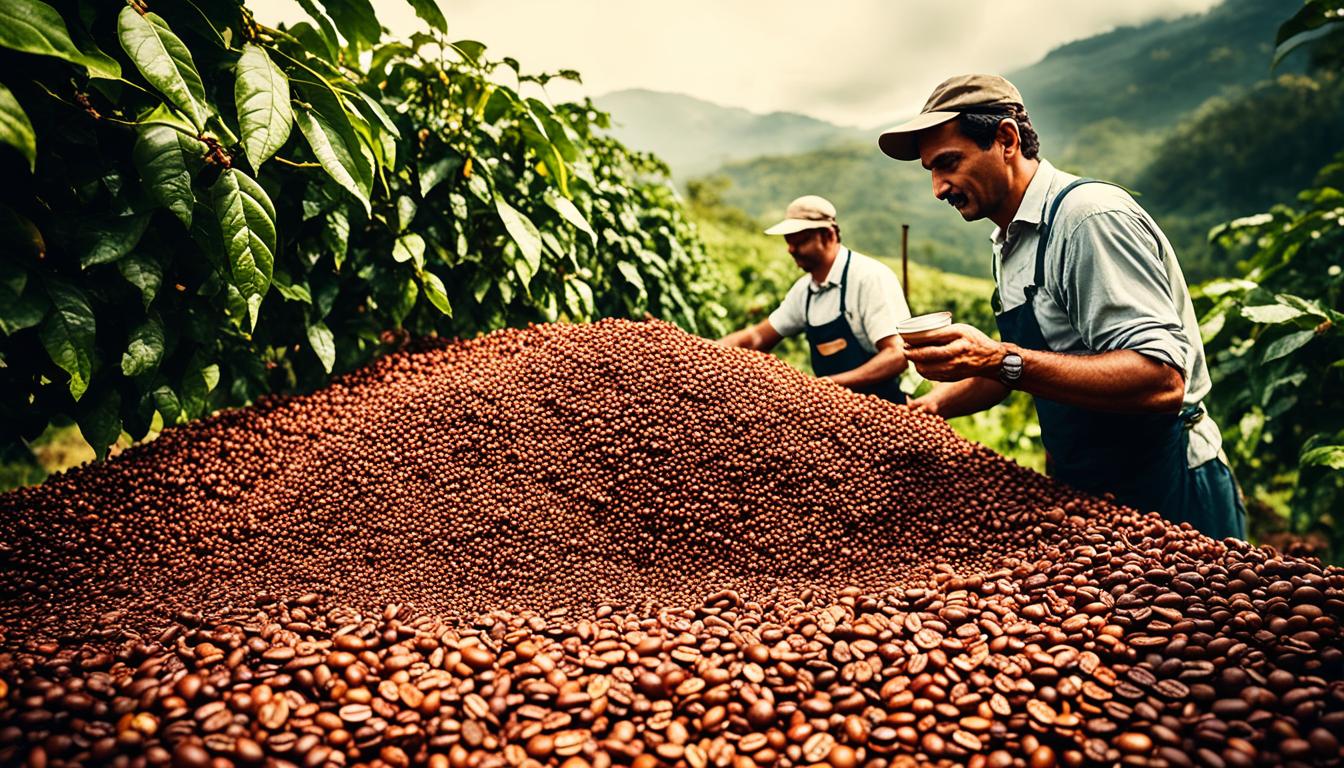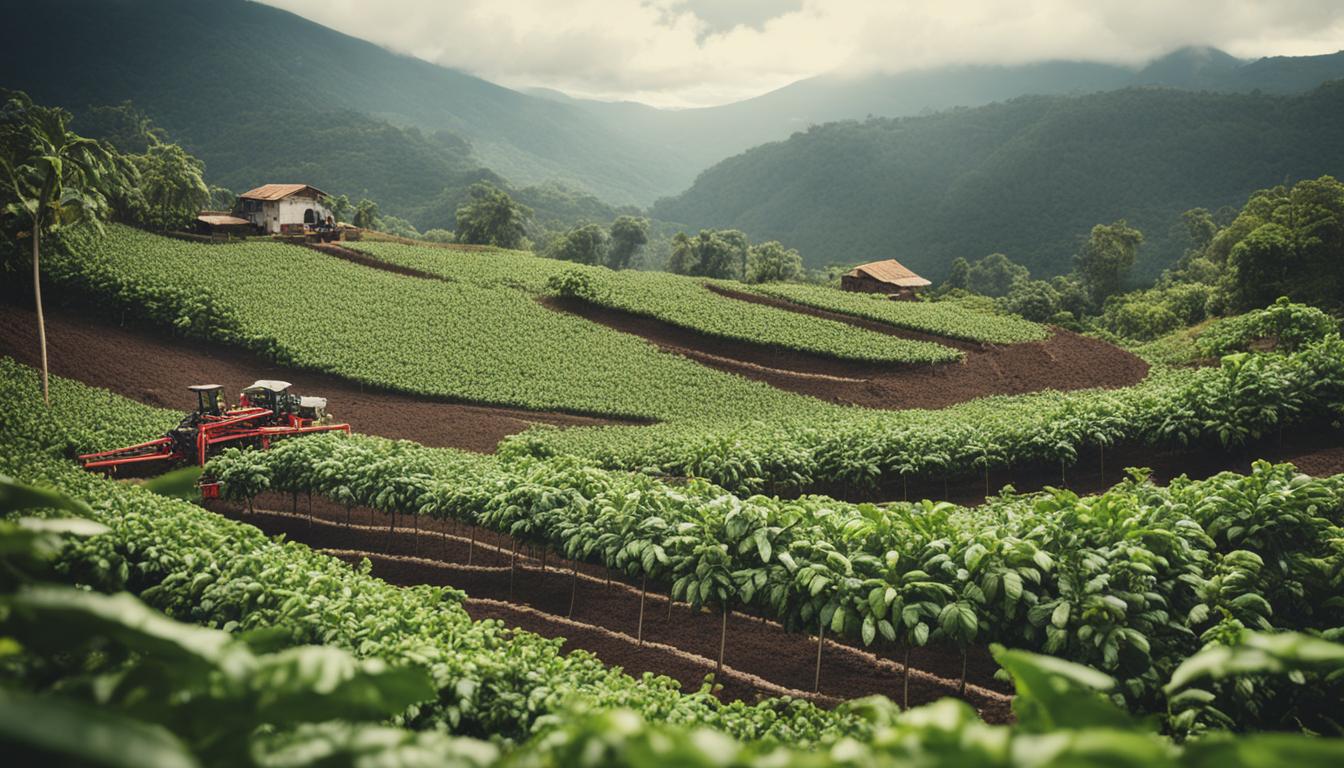Welcome to our comprehensive guide on coffee cultivation in Hawaii. Hawaii’s unique combination of rich volcanic soil, tropical microclimates, and skilled farmers has made it a renowned producer of premium coffee beans. From the famous Kona coffee plantations to specialty coffee growers across the islands, the Hawaiian coffee industry continues to thrive.
With a history dating back to the 1820s, the coffee industry in Hawaii has experienced significant growth over the years. Today, there are thousands of Hawaiian coffee farms contributing to the vibrant coffee industry on the islands. The sustainable and organic coffee production practices employed by Hawaiian farmers ensure the production of high-quality, environmentally-friendly coffee beans.
In this article, we will explore the history of Hawaiian coffee, the different coffee-growing regions in Hawaii, the unique qualities of Hawaiian coffee, and the options for coffee tours and cafes in the state. Join us as we take a deep dive into the world of Hawaiian coffee.
- Hawaii’s volcanic soils and tropical microclimates contribute to the production of premium coffee beans.
- The Hawaiian coffee industry has grown significantly, with around 6,900 acres of land dedicated to coffee cultivation.
- Kona is the most well-known coffee-growing region in Hawaii, but there are several other regions across the state.
- Hawaiian coffee is valued for its unique flavor profiles, which vary based on different growing regions and rainfall patterns.
- Coffee tours and cafes in Hawaii offer visitors the opportunity to experience the rich flavors of Hawaiian coffee and support local farmers.
A Brief History of Hawaiian Coffee
Let’s take a journey into the fascinating history of Hawaiian coffee, a beverage that has become synonymous with the islands’ rich culture and lush landscapes. From its humble beginnings to international recognition, the story of Hawaiian coffee is one that captivates and delights.
In the early 19th century, Hawaiian coffee was introduced to the islands by Reverend Samuel Ruggles. Reverend Ruggles brought coffee seeds from Brazil to the Big Island, sowing the seeds of what would become a thriving coffee industry. One particular region, Kona, emerged as a global coffee origin and gained international acclaim at the 1873 World’s Fair in Vienna.
The success of Hawaiian coffee was built on the hard work of smallholder farmers and the labor of migrant workers. European and American colonists, as well as workers from Japan, China, and native Hawaiians, contributed to the growth and cultivation of this beloved beverage.
In the past, sugar and pineapple production were the dominant industries in Hawaii. However, with the decline of these crops in the 1980s, the coffee industry began to flourish. The rise of global specialty coffee production and the increasing demand for higher quality and ethically sourced beans played a significant role in the growth of Hawaiian coffee, especially Kona coffee.
| Key Factors | Impact on Hawaiian Coffee |
|---|---|
| Sugar and Pineapple Production | Decline of these industries allowed coffee to take center stage in Hawaii’s agricultural landscape. |
| Global Specialty Coffee Production | Increased demand for specialty coffee created an opportunity for Hawaiian coffee to establish itself as a premium product. |
As coffee production in Hawaii began to thrive, the unique terroir of the islands played a crucial role. Volcanic soils, tropical microclimates, and favorable growing conditions contributed to the development of high-quality coffee beans.
Through its rich and eventful history, Hawaiian coffee has become an integral part of the islands’ heritage. It symbolizes the resilience of the coffee farmers, the diversity of cultures that came together, and the enduring spirit of Hawaii itself.
An image depicting the process of Hawaiian coffee cultivation, capturing the essence of its storied past.
Hawaiian Coffee Today
Hawaiian coffee production has experienced tremendous growth since the 1980s, establishing itself as the primary crop cultivated across the islands. According to the USDA Coffee Cultivation Report, an estimated 6,900 acres of land in Hawaii are dedicated to coffee production. The unique combination of favorable growing conditions and expert cultivation practices has contributed to the success of Hawaiian coffee.
Arabica coffee, known for its exceptional quality and flavor, is the main commercial coffee species grown in Hawaii. Additionally, small amounts of robusta coffee are also cultivated. To address pest issues, some farmers use Liberica as a rootstock for Kona coffee.
Coffee is cultivated in multiple regions across Hawaii, each with its own distinct characteristics. The major coffee growing regions include:
- Kona: Known for its exquisite taste and internationally renowned reputation, Kona coffee is grown on the slopes of the Mauna Loa volcano. The unique combination of rich volcanic soil, sunny climate, and cool breezes creates the perfect conditions for growing exceptional coffee beans.
- Ka’u: Located on the southern side of the Big Island, the Ka’u District is gaining recognition for producing high-quality coffee. The area’s rich volcanic soil and ample rainfall contribute to the unique flavor profiles of Ka’u coffee.
- Puna: Situated on the eastern side of the Big Island, the Puna region experiences higher levels of rainfall compared to other coffee-growing areas. The wet climate contributes to the production of distinct coffee varieties.
- Hamakua: The Hamakua region, located on the northeastern side of the Big Island, is characterized by its lush rainforest and unique microclimate. These conditions create a favorable environment for coffee cultivation.
- Maui: Known for its breathtaking scenery, Maui is also home to coffee farms. The region’s volcanic soil and ideal weather patterns contribute to the growth of exceptional coffee.
- Kauai: The island of Kauai is renowned for its stunning landscapes and also boasts coffee plantations. The fertile soil and tropical climate make Kauai an ideal location for coffee farming.
- O’ahu: Although smaller in size compared to other islands, O’ahu also has coffee farms. The island’s diverse microclimates allow for the cultivation of various coffee varieties.
- Molokai: With its tranquil atmosphere and rich agricultural heritage, Molokai is home to coffee farms that benefit from the island’s natural resources and favorable growing conditions.
In addition to commercial coffee production, coffee farming has become a popular pursuit among backyard farmers in Hawaii. Coffee can be grown in nearly any part of the islands, allowing individuals to cultivate their own coffee for personal consumption and enjoyment.
Distribution of Coffee Growing Regions in Hawaii:
| Coffee Growing Region | Location |
|---|---|
| Kona | The Big Island (Western side, Kailua-Kona) |
| Ka’u | The Big Island (Southern side) |
| Puna | The Big Island (Eastern side) |
| Hamakua | The Big Island (Northeastern side) |
| Maui | Island of Maui |
| Kauai | Island of Kauai |
| O’ahu | Island of O’ahu |
| Molokai | Island of Molokai |
Whether it’s the commercial coffee farms or the efforts of backyard coffee farmers, Hawaiian coffee continues to thrive, offering a delicious and diverse range of coffee varieties.
“Hawaii’s unique coffee growing regions, with their distinct climates and soil compositions, contribute to the exceptional flavors and quality found in our coffee beans.” – Hawaiian Coffee Farmer
What Makes Hawaiian Coffee Unique?
Hawaiian coffee stands out for several reasons. Firstly, the state’s adherence to federal minimum wage laws ensures that a significant portion of the consumer’s cost directly benefits coffee farmers, making Hawaii’s coffee supply chains more equitable. Additionally, the unique terroir of Hawaii, including suitable temperatures, soils, and infrastructure, contributes to the profitability of coffee cultivation.
The climate, influenced by latitude and altitude, allows coffee to be grown at lower altitudes compared to other countries, resulting in a unique flavor profile characterized by sweetness. However, it’s important to note that flavor profiles may vary across different growing regions due to differing rainfall patterns. For example, Kona is dry and sunny, while Puna experiences more rainfall, leading to a diverse range of flavor profiles.
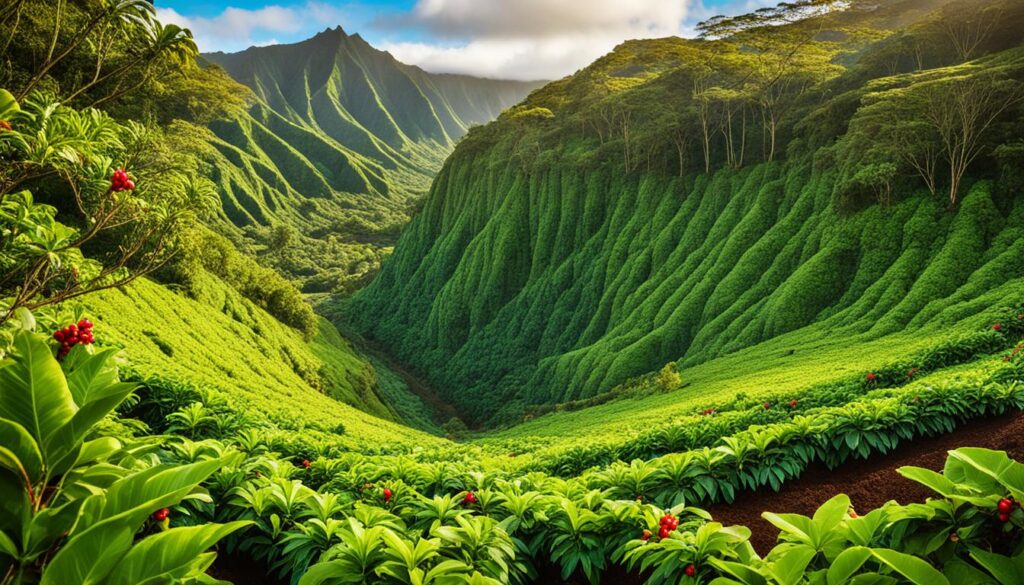
In summary, the equitable coffee supply chains, unique terroir, climate and altitude, and varied growing conditions in different regions contribute to the distinctiveness of Hawaiian coffee. These factors create an extraordinary coffee experience that cannot be replicated anywhere else.
Coffee Growing Regions of the Big Island
The Big Island of Hawaii is renowned for its diverse coffee growing regions, each offering unique flavors and characteristics. Let’s explore the prominent coffee regions that contribute to the rich tapestry of Hawaiian coffee.
Kona Coffee Belt
The most well-known region on the Big Island is the Kona Coffee Belt, located between the Mauna Loa and Hualalai volcanoes. This area boasts over 900 farms, cultivating the world-famous Kona coffee. The favorable climate, rich volcanic soil, and ideal elevation contribute to the exceptional quality of Kona coffee.
| Grade | Description |
|---|---|
| Kona Extra Fancy | The highest grade of Kona coffee, featuring large, perfectly shaped beans with outstanding flavor. |
| Kona Fancy | A high-quality grade with slightly smaller beans than Extra Fancy, but still boasting excellent flavor. |
| Kona Peaberry | A unique grade where beans grow individually in cherries, resulting in a distinct and concentrated flavor. |
In addition to the classic Kona Typica beans, other varieties like the Kona Typica mutation are also grown in this region, adding further diversity to the Kona coffee offerings.
Ka’u Coffee
The Ka’u District, located on the southern part of the Big Island, is an emerging coffee region with a growing reputation. Ka’u coffee has gained recognition through national competitions and is celebrated for its distinct flavors. This area’s volcanic soil and favorable climate contribute to the unique characteristics of Ka’u coffee.
Hamakua Coffee
Located on the northeastern side of the Big Island, the Hamakua region is known for its lush green landscapes and abundant rainfall. Hamakua coffee benefits from the fertile soil and humid climate, resulting in flavors that are distinct from those found in other coffee-growing areas of Hawaii.
As you can see, the Big Island of Hawaii is a paradise for coffee lovers, offering a range of flavors and coffee grades from its different regions. Whether you’re savoring a cup of Kona coffee from the renowned Kona Coffee Belt, experiencing the unique taste of Ka’u coffee, or enjoying the distinct flavors of Hamakua coffee, each region showcases the exceptional quality and diversity of Hawaiian coffee.
Coffee Tours and Cafes in Hawaii
Visitors to Hawaii have the opportunity to experience the magic of Hawaiian coffee through immersive tours and visits to local cafes. Whether you’re a coffee enthusiast or simply looking to enjoy a delicious cup of joe, Hawaii offers a variety of options for everyone.
Coffee Tours:
If you’re interested in learning about the intricate process of coffee cultivation, a tour of a coffee farm is a must. Here are some popular coffee tour options in Hawaii:
| Farm | Tour Details |
|---|---|
| Greenwell Farms | Located in the heart of the Kona Coffee Belt, Greenwell Farms offers free tours that provide insights into the coffee growing process. You can witness coffee picking, processing, and roasting firsthand. |
| Sunshower Coffee Farm | If you prefer a more personalized experience, Sunshower Coffee Farm offers private tours. You can explore their picturesque farm, learn about sustainable farming practices, and enjoy a tasting session. |
| Hilo Coffee Mill | Situated in the Puna region, Hilo Coffee Mill offers informative tours with an emphasis on the coffee milling process. You’ll have the opportunity to see how coffee cherries are transformed into the beans we all love. |
| Ka’u Coffee Mill | Located in the scenic Ka’u District, Ka’u Coffee Mill provides guided tours that encompass all aspects of coffee production. From the farm to the mill, you’ll gain a comprehensive understanding of the coffee-making process. |
Cafes in Kona:
Kona is famous for its coffee culture, and there are several cafes where you can savor the flavors of Hawaiian coffee. Here are a few popular options:
- Kona Coffee & Tea
- Koana
- Miranda’s Farms
These cafes not only offer a wide range of Hawaiian coffee varieties to choose from but also provide a cozy and inviting atmosphere where you can relax and enjoy your favorite brew.
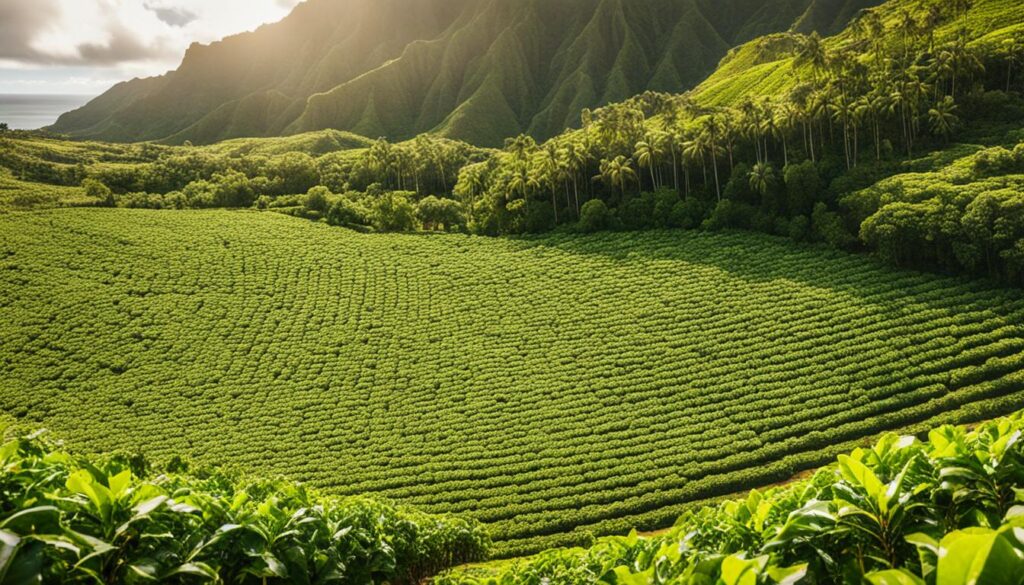
Immerse yourself in the world of Hawaiian coffee by taking a tour and exploring the local cafes. It’s a memorable experience that allows you to appreciate the artistry, passion, and dedication behind every cup of Hawaiian coffee.
The Essence of Kona Coffee
Kona coffee is more than just a type of coffee; it represents the essence of Hawaii and its unique connection to nature and community. When we drink Kona coffee, we are invited to be mindful of the rich volcanic soil, the refreshing rain, the warm sun, and the oceanic influences that shape the flavor and character of the islands.
The Hawaiian lifestyle is deeply rooted in an appreciation for the environment and a sense of interconnectedness with the land and sea. This connection is reflected in every sip of Kona coffee, allowing us to experience the spirit of Hawaii and carry the aloha spirit with us, no matter where we may be.
Whether we are enjoying a cup of Kona coffee in the comfort of our homes or visiting Hawaii to explore its coffee farms, we can embrace the mindfulness and appreciation that comes with each pour. The essence of Kona coffee goes beyond its exceptional flavor; it embodies the spirit of the Hawaiian lifestyle, the connection to nature and community, and the warmth of the aloha spirit.
“Drinking Kona coffee is an opportunity to be mindful of the rich volcanic soil, cooling rain, warm sun, and oceanic influences that shape the flavor and character of the islands.”
The Mindful Art of Coffee Tasting
As we savor each sip of Kona coffee, we can engage in the mindful art of coffee tasting. Taking a moment to focus our senses on the aroma, the taste, and the texture of the coffee allows us to fully appreciate its nuances. By being present in the moment and embracing the sensory experience, we can deepen our connection to the coffee and the Hawaiian culture it represents.
A Connection to Nature and Community
Kona coffee is a product of its unique natural environment. The volcanic soil, the gentle rainfall, the tropical climate, and the nurturing hands of local farmers all contribute to the exceptional quality of Kona coffee. By supporting the coffee industry in Hawaii, we can help sustain the delicate balance between nature, agriculture, and community.
Embracing the Hawaiian Lifestyle
Embracing the spirit of Kona coffee means embracing the Hawaiian lifestyle. The Hawaiian people have a deep respect and reverence for the land, the sea, and their sense of community. By enjoying Kona coffee, we can connect with this way of life and carry its values of respect, harmony, and aloha spirit into our own lives.
- Experience the unique connection to nature and community that Kona coffee embodies.
- Engage in the mindful art of coffee tasting, savoring each sip and savoring each moment.
- Embrace the Hawaiian lifestyle and carry the aloha spirit with you wherever you go.
Conclusion
Exploring coffee cultivation in Hawaii has been an enriching experience, unveiling a vibrant industry deeply intertwined with the island’s history, unique growing conditions, and rich flavors. At Hawaiian coffee farms, especially those in Kona, visitors have the opportunity to delve into the cultivation process, witness the passion and dedication of specialty coffee growers, and savor the distinct taste of Hawaiian coffee. Yet, the Hawaiian coffee experience encompasses more than just taste. It fosters a profound appreciation for the land, the community, and the timeless Hawaiian lifestyle.
Appreciating Hawaiian coffee goes beyond sipping a cup of carefully brewed coffee; it is a embrace of the deep-rooted connection between nature, culture, and ourselves. The lush volcanic soils, cooling rain, warm sun, and oceanic breeze infuse their magic into every sip, allowing us to experience a true taste of the islands. We become partakers in the “aloha spirit” – the genuine warmth, love, and respect for both people and the environment that Hawaii is renowned for.
Supporting sustainable coffee farming in Hawaii is paramount to preserve this cherished industry for future generations. By prioritizing ethical and environmentally friendly practices, we ensure the longevity of Hawaiian coffee and contribute to the thriving coffee culture of the islands. Together, we can continue to celebrate and indulge in the appreciation of Hawaiian coffee – an experience that encompasses history, unique flavors, and a sustainable future.
FAQ
What is the history of coffee cultivation in Hawaii?
Coffee cultivation in Hawaii has a rich history that began in the 1820s when coffee was introduced to the islands by Reverend Samuel Ruggles. The industry grew primarily through the efforts of smallholder farmers and migrant workers, and Kona coffee gained international recognition at the 1873 World’s Fair in Vienna.
How much coffee does Hawaii produce?
Hawaii produces around 5 million pounds of green coffee per year, with approximately 6,900 acres of land dedicated to coffee cultivation. Arabica is the main commercial coffee species grown in Hawaii, with small amounts of robusta also cultivated.
What makes Hawaiian coffee unique?
Hawaiian coffee stands out for several reasons, including its adherence to federal minimum wage laws that benefit coffee farmers. The unique terroir of Hawaii, including suitable temperatures, soils, and infrastructure, contributes to the profitability of coffee cultivation. The climate allows coffee to be grown at lower altitudes, resulting in a unique flavor profile characterized by sweetness.
Where are the coffee growing regions in Hawaii?
Coffee is grown in various regions across Hawaii, including Kona, Ka’u, Puna, Hamakua, Maui, Kauai, O’ahu, and Molokai. Each region has its own unique characteristics and contributes to the overall diversity of Hawaiian coffee.
Are there coffee tours and cafes in Hawaii?
Yes, visitors to Hawaii have the opportunity to experience coffee cultivation first-hand through coffee tours and visits to local cafes. Some popular options include Greenwell Farms and Sunshower Coffee Farm in Kona, Hilo Coffee Mill in Puna, Ka’u Coffee Mill in the Ka’u District, and cafes like Kona Coffee & Tea, Koana, and Miranda’s Farms.
What is the essence of Kona coffee?
Kona coffee represents more than just a type of coffee; it embodies the essence of Hawaii and its unique connection to nature and community. Drinking Kona coffee allows one to experience the spirit of Hawaii and carry the aloha spirit with them, no matter where they may be.

